

Despite the current economic slowdown, the PLM (product lifecycle management) market continues to grow steadily in several market sectors (automotive, aerospace & defense, industrial equipment, etc.) and regions (North America, China, etc.). This is due in part to solution enhancements by leading PLM suppliers that fit well with the current digital enterprise initiatives at many end user organizations.
One of the major emerging trends in the PLM solution space is the expansion of the overall product and manufacturing lifecycle. Increasingly, this is referred to as the digital enterprise. In the digital enterprise, all aspects of product design, test, manufacturing, and supply chain are interconnected across a digital thread of virtual design, simulation, production processes, analytics, and systems engineering. The focus today is on the next generation of smart connected products 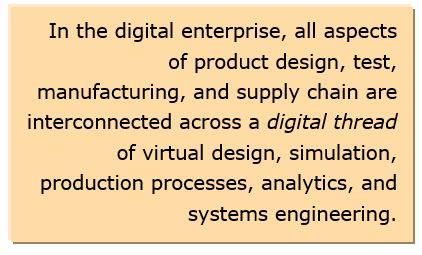
A significant component of the digital thread is the concept of the digital twin, where the physical product, equipment, or system is connected to the virtual design model allowing a constant stream of performance information on the product in the field. PLM suppliers provide the design technology that enable smart connected product design that will enable the implementation of the digital twin. PLM product design virtual models represent the virtual component of the digital twin, with product design criteria now focusing on designing smart, connected products.
Another continuing trend for PLM is the overall systems engineering or model-based design approach to product design. This involves considering product design within the context of multiple engineering disciplines (mechanical, electrical, software). Product development across all industry sectors is moving to meet the requirements for smart and connected products to support the IoT. This applies whether the product is a car, appliance, consumer product, or mobile device.
From the manufacturing perspective, we’re seeing a move to designing next-generation edge devices that will support the IIoT, with intelligent, connected factories, production lines, and equipment.
There is a fundamental shift taking place in product design where all products will need to be designed to be intelligent, connected, and function within the ecosystem they are designed to support. Significant opportunities in both design and manufacturing will come from expanding the digitally connected world and devices, machines, and production lines.
PLM solution providers are addressing and developing IoT/IIoT strategies and solutions. In some cases, these solutions are industry-specific. PLM suppliers regard IoT as an architecture of layers.
These start at the lowest level of objects, devices, and products, which represent the design layer for designing smart connected products. Additionally, PLM suppliers are focusing on the top of the IoT stack, or the business layer. Here, the objective is to develop industry-specific IoT/IIoT business apps that provide manufacturers with product development and production process methods to implement IoT technologies that are specific to their unique requirements and processes.
At the factory/plant level PLM suppliers are enabling customers to make the transition to the next generation of smart connected factories where it will be necessary to design and architect production systems, automated work stations, and assembly lines into a factory system of systems. This is the essence of the IIoT and smart manufacturing where there is communication between intelligent products, machines, and systems.
PLM suppliers are now offering analytics applications that focus on factory and plant operations. Advanced analytics will play a significant role in two primary areas: predictive maintenance and operational intelligence. On the operational intelligence/continuous process improvement side, predictive and prescriptive analytics solutions will validate “as-built” to “as-designed” and help companies implement closed-loop PLM. On the maintenance side, predictive analytics are already being used to improve product performance in the field. This is a major component of the concept of the digital twin.
Major PLM providers have either made acquisitions or have developed manufacturing operations management solutions to address manufacturing execution systems (MES) at operations level. This extends the product lifecycle to the factory floor, allowing manufacturers to close the loop from operations and quality back to the manufacturing processes and product design that will allow continuous process improvement.
Service lifecycle management is emerging as a natural extension of the product lifecycle. Major PLM suppliers are embracing this trend, which offers significant potential value for product suppliers and end users alike for both post-sales remote diagnosis and service support and ongoing product improvements (via the concept of the digital twin, where physical products and equipment will be connected to the virtual engineering, enabling performance optimization and improved design).
While most PLM solution users to date have been in the discrete manufacturing industries such as automotive, aerospace & defense, heavy equipment, industrial fabrication & assembly, machine tools, and high-tech & electronics; PLM solutions are now being readily adopted by a new set of industrial verticals such as medical devices; consumer packaged (and other) goods; retail; ship building; energy generation; utilities; and architecture, engineering & 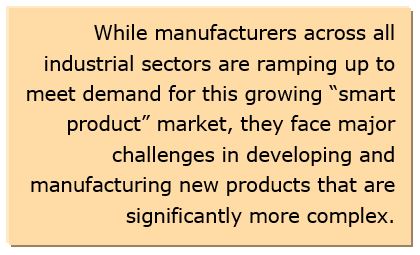
Manufacturers across multiple industries, scrambling to develop and manufacture the next generation of smart products, face major challenges in developing and manufacturing new products that are significantly more complex. These mechatronic products require mechatronic design approaches in which mechanical, electrical, and software engineering disciplines are integrated. Many consumer goods companies and other manufacturers are turning to systems engineering discipline development practices that have been proven in high-tech industry sectors like embedded systems, electronics, aerospace & avionics, and automotive.
In response, product lifecycle management solution providers now offer systems engineering design platforms and solutions across multiple domains of the product lifecycle, including production systems. These allow engineers to apply a model-based, “system of systems” engineering approach to mechatronic product and process development. PLM suppliers are also offering more comprehensive systems-based product test simulation solutions that allow engineers to test and simulate using a more holistic systems behavior approach. Systems engineering-based design platforms provide product developers and production system engineers with tools to integrate mechatronic systems using a functional design approach that allows for early stage validation. This helps reduce the time and cost of design recycles and late stage integration.
Today, companies have access to technology and solutions that allow for a completely connected digital enterprise in terms of an end-to-end virtual lifecycle of product design, manufacturing processes, shop floor production systems, operational support and maintenance, and service in the field. Leading PLM suppliers often refer to this technology and solution set as “closed-loop PLM.” Here, the digital thread ties together all aspects of the product lifecycle and enables all product stakeholders, product design, manufacturing and production systems, and product services to work from a common repository of digital information.
An important aspect and enabler of the digital thread is the concept of the digital twin. A digital twin, as the name implies, is the virtual representation of a physical asset. It is an archive of historical information and real- time data. Historical information such as drawings, models, bills of material, engineering analysis, dimensional analysis, manufacturing data, and operational history can be used as a baseline when benchmarking performance. Similarly, real-time data acquired via integrated sensors or external sources can be used for a multitude of analytic tasks such as condition monitoring, failure diagnostics, prescriptive analytics, and predictive analytics.
Knowledge gained by employing these methods can add value to the service life of the asset in many ways: improving efficiency, reducing downtime, anticipating failures, etc., and can provide valuable insight for continuous improvement projects at the design and manufacturing levels. With the emergence of the digital twin, the notion of closed-loop design extends beyond the normal supplier scope and through the entire product lifecycle.
The relative benefit to be gained from the digital twin will depend on the nature of the product and volume and quality of information retained throughout its lifecycle. As historically simple products increase in complexity, the demand for digital twins will grow rapidly.
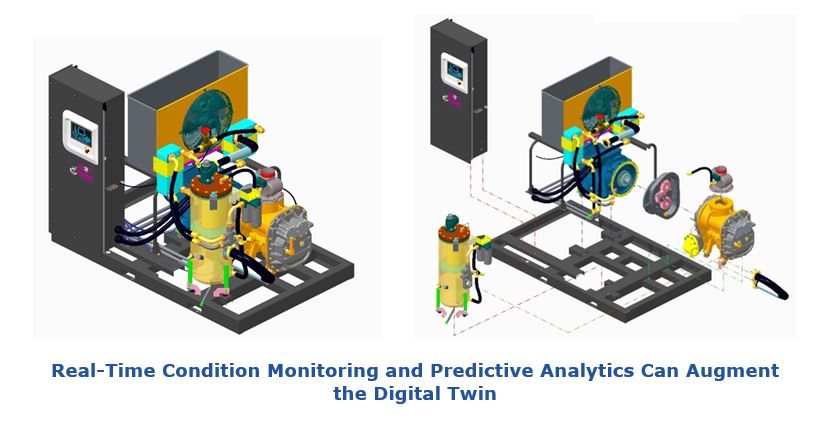
A unique aspect of the digital twin is its ubiquity across the product lifecycle. A genuine digital twin will contain information about its design, manufacturing, and service life. This raises questions such as, who owns the digital twin and the data that it accesses?
Equipment OEMs typically consider information like engineering analysis, calibration data, and end-of-line performance to be company-confidential. End users show the same reservations when it comes to sharing operational performance data. For the digital twin to be effective, these two sources of information must have transparency in at least one direction. This characteristic could promote a symbiotic sharing of information or, alternatively, a service-based business where the OEM maintains ownership of both digital and physical assets.
Consequently, manufacturing OEMs and capital equipment suppliers are taking a hard look at existing business models around maintenance and support of their equipment. With the availability of tools such as predictive and prescriptive analytics and continuous condition monitoring, they are considering new business models based on services and support in which the OEM maintains ownership of the equipment and sells a service to the customer.
Implementing an enterprise asset management and lifecycle services strategy around the concept of the digital twin (and within the context of an overall IIoT ecosystem) can provide significant benefits for both the equipment OEM and 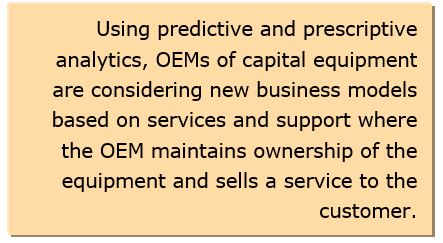
Suppliers of capital equipment may now be able to offer business models that comprise operational-based revenue rather than capital equipment sales predicated on equipment that could be monitored for both performance and maintenance status. An example of this is the “power by hour” business model used by aircraft engine suppliers. Parts and services suppliers within maintenance, repair and overhaul (MRO) will use IIoT to monitor distributed inventories, perishable parts conditions, and production rates. This will create entirely new and very closely linked business relationships between manufacturers and their equipment suppliers.
Perhaps one of the most significant benefits for the owner-operator of OEM-furnished equipment in the field is the direct support of maintenance technicians with the latest and most accurate information on the state and condition of the equipment. Data from smart, connected equipment that has been aggregated and analyzed and transformed into actionable information enables maintenance staffs to focus directly on issues at hand, rather than going through lengthy troubleshooting processes.
One specific area that holds promise for support and maintenance is augmented reality along with new user interfaces and mobility devices. The digital user interface of the smart, connected equipment can be put into a tablet or smartphone application. This would enable remote operation and inspection and, in some cases, eliminate the need for controls. It would also enable greater mobility for the maintenance technician.
Augmented reality involves pointing a tablet or smartphone at the equipment or using smart glasses to generate or access a virtual model overlay of the physical equipment. This overlay contains monitoring, operational, and service information, as well as the actual engineering model of the part or assembly, making it easier and more efficient to support and service the equipment.
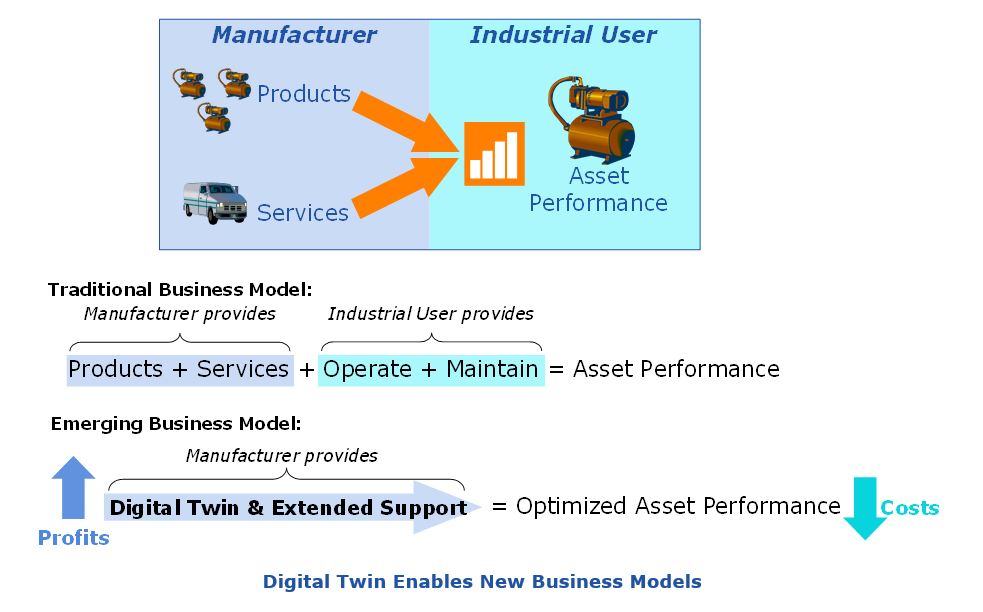
The product designer will need to dispense with the notion of creating a non-connected, standalone machine or piece of equipment, and design within the much broader context of connectivity, intelligence, and -- most importantly -- the inherent value the connected product will provide to its environment.
The new design paradigm also means designing to combine the physical product with the virtual, that is, designing the product to be the digital twin from the very beginning. The product lifecycle would include the concept, design, manufacture, and now in the user environment, connected and providing information to enable service and an enhanced operational and maintenance experience.
Increasingly, next-generation predictive and prescriptive analytics solutions are being applied to help optimize product manufacturing and production operations. These analytics solutions all use various forms of machine learning algorithms and other statistical and rules-based methods to examine and identify patterns in the production process. 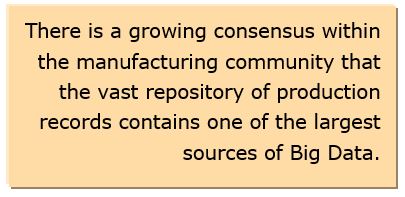
There is a growing consensus within the manufacturing community that the vast repository of production records contains one of the largest sources of Big Data. These include completed operational and executed work records, quality assurance records, work flow histories, operational deviations and variations, engineering changes, machine and tooling metrics, material data, and many other records related to the production process.
Most of these data are routinely maintained and archived because certain industries like A&D, automotive, pharmaceutical, medical devices, and others have mandated regulatory requirements. Today's operational analytics applications for manufacturing can glean through this production process-related Big Data. Using machine learning (ML), multi-variant statistics, and rules-based logic, predictive analytics engines can empirically reveal the origins of the most complex problems. Prescriptive analytics solutions can go beyond this by also suggesting decision options to resolve them.
An anticipated progression of advanced analytics is going beyond predictive to prescriptive analytics, where manufacturing engineers bring together Big Data, statistical sciences, rules-based logic, and machine learning to empirically discover and reveal the origins of the complex problems, and then determine decision-based options to resolve them.
Because a typical large OEM can accumulate so much data that the only effective way to analyze the sum total of these records is through large-scale pattern matching technology enabled by current machine learning algorithms. What ML already does exceedingly well—and will get even better at—is processing any amount of data and every combination of variables. Eventually, pattern matches are made and predictable outcomes form that, in the case of product process records, can result in a set of rules and best practices that lead to overall process improvement and better product designs. The process is straightforward and relatively simple in theory, but can involve some rather complex algorithms and access to a lot of data.
Product lifecycle management (PLM) suppliers have a clear stake in and are delivering technology, applications, and products that support IIoT. PLM suppliers provide their customers with tools and solutions that allow manufacturers to design and build products. A lot of these products are focused on the needs and desires of the consumer, from cars and 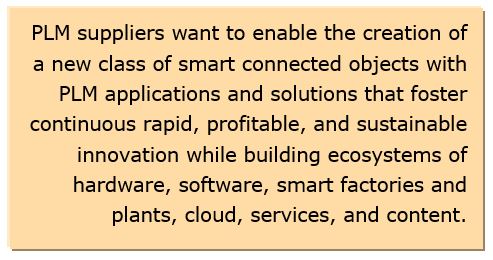
IIoT is often regarded to be a set of strategies, frameworks, and technologies that define connected networks, smart factories, plants, and businesses; but everything in the IIoT environment begins with the smart connected object, which - in this case - just happens to a product. And this is how the PLM providers are approaching the overall concept of IoT, IIoT, and Industrie 4.0. They want to enable the creation of a new class of smart connected objects with PLM applications and solutions that foster continuous rapid, profitable, and sustainable innovation while building ecosystems of hardware, software, smart factories and plants, cloud, services, and content.
Manufacturing and production systems will undergo significant changes with the emergence of IIoT technologies, smart and connected factories and supply chains. We will see a steady progression from simply monitoring machines and production lines to optimizing production processes, to predictive and prescriptive analytics, to possibly autonomous “lights out” factories of the future. Within this progression, two distinct sets of predictive analytics solution sets are emerging: one for product development and one for factory operations.
In the case of product design, it is more about product test simulation tools, multi-discipline systems engineering methods, and an emerging branch of product development called predictive engineering analytics (PEA). One of the most sought after, but elusive, goals of product design engineering is to validate that you have achieved all design criteria in the as-built product before the product is manufactured. In a sense, this means closing the loop between the as-built and as-designed, and validating that the physical product will meet all design criteria through simulation of product behavior and performance before the product is manufactured. This will not eliminate the need for testing the physical product, but will provide engineers with much better information about the product and shorten the physical test cycle.
To meet the requirements for the IoT and a new generation of smart connected products, product designers are adopting a closed-loop, systems-driven approach. This approach involves a decomposition of all the functional elements, while considering all intended interactions from all the engineering disciplines involved, and controlling the overall system behavior.
This approach minimizes risk and avoids late-stage changes by understanding both the boundary limits for subsystems and the global system's behavior at every stage of the development process. Further, PEA will enable continuous design improvements that will make simulation a predictive driver of the product development.
As multi-discipline CAD systems evolved into a portfolio of design/build applications and manufacturers across all industries adopted a lifecycle approach to product development, PLM has become a strategic business decision for its users.
Today, the industries that have adopted and established PLM solutions are seeing PLM evolve into a key enabler for the 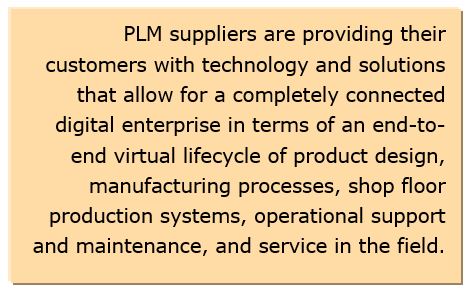
The concepts and subsequent technologies emerging from the PLM solution providers like the digital twin are not only helping companies optimize maintenance and production processes, but causing them to examine and change established business models to benefit both their customers and bottom lines.
PLM users should take a close look at the concepts and solutions that their PLM suppliers are offering, from IoT/IIoT platforms to advanced analytics for manufacturing, to IoT business apps. PLM will remain a strategic business decision for manufacturers, however the users will need to align with their suppliers as they move into the digital enterprise and all of the associated business aspects.
If you would like to buy this report or obtain information about how to become a client, please Contact Us

